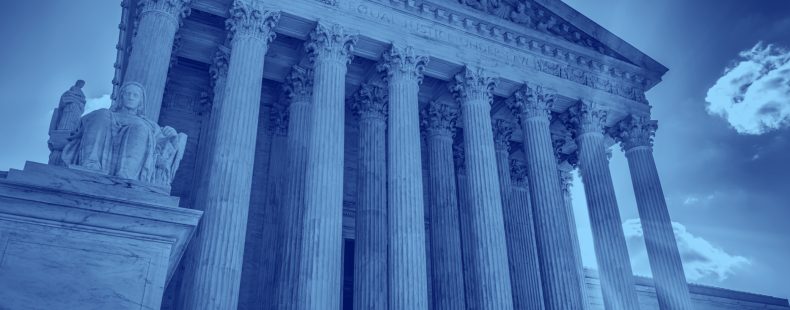As the nation’s highest court, the US Supreme Court takes on some of the most complex—and often the most controversial—cases. Often adding to the complexity and confusion around the cases and rulings themselves are the formal legal terms used in the justices’ written decisions—and in the analysis of them.
In this guide, we’ll cover some of the most common legal terminology used in relation to Supreme Court cases and rulings. We’ll translate the legal jargon into plain language with simple, easy-to-understand legal definitions so you can decipher the text used to render the consequential decisions.
writ of certiorari
A writ of certiorari, often shortened to just certiorari, is a demand from a higher court to a lower court to transfer the records of a case from the lower court to the higher court for review. Typically, the Supreme Court only uses the certiorari process to determine which cases it will decide to hear. A person seeking the Court’s review must first petition the Court for a writ of certiorari.
In order for the Supreme Court to take a case, four of the Supreme Court justices must agree to review the case. If four justices agree, the Supreme Court will accept the petition and submit a writ of certiorari to a lower court. Because the Supreme Court is the highest federal appellate (appeals) court, it will typically submit a writ of certiorari to a federal circuit appellate court or the highest appellate court in a state. Whether or not a petition is accepted is entirely up to the Court’s discretion and the Court is not legally required to state why it has accepted or rejected a petition.
amicus curiae
The term amicus curiae, which in Latin literally means “friend of the court,” refers to a person who is not a formal party in a case but who submits information to the court in the form of a document known as a brief of amicus curiae or amicus curiae brief (the term amicus curiae is sometimes informally used as a short way of referring to this brief). Typically, an amicus curiae advises the court on a complex law or confusing technical matter. A party considered an amicus curiae often volunteers their advice, but the Supreme Court may also invite an amicus curiae to offer their expertise or opinion. In many cases, such advice is provided as a way of urging the justices to support a particular decision.
During each term, the Supreme Court typically accepts many hundreds and possibly over a thousand amicus curiae briefs across all cases. In particular, cases that involve controversial issues often result in a very large number of interested individuals and groups submitting amicus curiae briefs to the Court in an attempt to influence the decision. These briefs can be very influential and some may even be cited by the justices when delivering their written opinion.
petitioner
In the context of the Supreme Court, the petitioner is the person or group who files a petition for a writ of certiorari to the Supreme Court. The petitioner may also be referred to as the appellant (the one appealing the decision). The petitioner is typically the side that previously lost the case in a lower court.
respondent
The respondent is the person or group on the side opposing the petitioner. The respondent is also referred to as the appellee. The respondent is typically the victorious side in the previous lower court decision that is being appealed. It is possible for individuals, organizations, companies, or government agencies—or the US government itself—to be either the petitioner or the respondent.
brief of merits
A brief of merits (or merits brief) is submitted by a petitioner after the Supreme Court has accepted their petition for a writ of certiorari. Typically, the brief of merits presents the legal questions under review in the case, lists who is involved, states what the previous court’s decisions were, and presents the petitioner’s legal argument. The respondent then presents their own brief of merits in response. Supreme Court justices rely on such briefs to determine each side’s argument and what prior legal decisions the arguments are based on.
docket
In the context of law, the word docket refers to the list of cases that a court is scheduled to hear. The Supreme Court also uses the term docket to refer collectively to all of the filings, briefs, requests, and other legal documents that make up a case. All case dockets and the Court’s docket calendar are available for public view on the Supreme Court website.
In recent times, the term shadow docket is used (usually in a critical way) to refer to cases or issues that are resolved by the Supreme Court without oral arguments or public records. Unlike the primary docket, known as the merits docket, the so-called shadow docket includes decisions or rulings made without transparency or publicly available information.
What does freedom of speech mean?
precedent
In law, a precedent is a legal decision that serves as an authoritative one that’s consulted in future cases—and on which future decisions may be based. The Supreme Court justices will often cite prior precedents established by the Supreme Court itself or other courts to support their decisions. Similarly, lawyers will also often cite precedents when arguing their side before the Supreme Court. It is possible for the Supreme Court to reach a decision that disagrees with a prior precedent. When this happens, the new judgment is typically considered the new precedent going forward. Many landmark cases are referred to as such because the Court altered a precedent or established a new one.
Because it is the highest court in the land, the Supreme Court’s decisions overrule any precedents set by lower courts. Because of this, state and lower federal courts will often base their decisions on precedents established by the Supreme Court.
preemption
This brings us to the concept of preemption. In law, the term preemption refers to the legal fact that the decision of a higher court replaces or preempts the decision of a lower court. If the decisions of a higher court and a lower court disagree, the higher court’s decision overrules the lower court’s decision, which is thrown out. In US law, the legal justification of preemption is established in the Supremacy Clause of the Constitution.
In the US, the Supreme Court is the highest federal court. This means that any decision it reaches overrides any decisions made by any lower court in the nation. The Supreme Court has the highest level of federal preemption and its decisions override all state laws that contradict its rulings. As a result, state law is often carefully crafted to agree with Supreme Court precedents and rulings.
nullification
The term nullification refers to a legal theory that argues that states have the power to ignore or nullify federal laws that they believe to be unconstitutional. Throughout US history, there have been several noted instances in which states unsuccessfully attempted to nullify federal laws. For example, in 1957 the state of Arkansas attempted to ignore the ruling in Brown v. Board of Education that stated segregation in public schools was illegal. In response, President Dwight Eisenhower deployed the US Army to enforce federal law.
Unsurprisingly, the Supreme Court has repeatedly ruled that states do not have the power of nullification. This hasn’t stopped states from attempting to use nullification to ignore federal laws they disagree with. Even in modern times, attempts at nullification have ultimately proven unsuccessful and typically face strong resistance and condemnation from the Supreme Court.
originalism
Originalism is a legal philosophy that says that the Constitution should be interpreted based on the meaning it had when it was originally written. A person who supports originalism can be called an originalist. Originalism is not concerned with the intentions of the Constitution’s authors and does not support the idea that the meaning of the Constitution changes alongside societal values or as a result of later Supreme Court decisions.
Originalism is often viewed as a conservative philosophy. On the current Supreme Court, Justices Clarence Thomas, Neil Gorsuch, Brett Kavanaugh, and Amy Coney Barrett have described themselves as originalists.
strict constructionism
Strict constructionism, often referred to as original intent, is a legal philosophy similar to originalism that says that only the exact text of the Constitution matters when deciphering its meaning. Strict constructionism is often thought to be an even less flexible approach to reading the Constitution than originalism as it relies purely on a strict, literal view of the Constitution based on when it was originally written. A strict constructionist does not accept the idea of changing definitions of words and reads each word of the Constitution with the meaning it had at the time of its writing.
Because they are so close in meaning, originalism and strict constructionism are often used interchangeably to refer to conservative judicial philosophies. For example, former Justice Antonin Scalia, who referred to the Constitution as a “dead” document (that is, one that never changes in meaning), was often described as being both an originalist and strict constructionist.
contextualism
Contextualism is a legal philosophy that says the Constitution should be interpreted based on the context surrounding the time it was written. Contextualism is usually seen as the opposite of strict constructionism or what’s called textualism, philosophies based on the notion that only the text of the Constitution matters when interpreting it. A supporter of contextualism looks beyond the text and considers what the authors’ goals and intent were when the Constitution (or an amendment) was written. A contextualist considers what exactly a particular section of the Constitution was trying to accomplish rather than just looking at what it literally says.
Supporters of contextualism are more likely to view the Constitution as a “living document,” meaning that interpretations of it may change as society and technology change. For example, a contextualist’s interpretation of the Second Amendment may be based on the fact that it was written at a time when the only firearms widely available were single-shot muskets (whose power has been exceeded by modern firearms like automatic weapons).
Take our quiz on these terms
We hope you have a better understanding of these complex and important legal terms. You can refresh your memory on them any time by visiting our Legal Glossary Word List. If you want to test your knowledge, head over to our short quiz on this Supreme Court language.














